Cats have a reputation for being independent creatures, but many cat owners wonder if their furry friend will remember them after a prolonged absence. In this article, we will explore the intricacies of cat memory and behavior to determine if your cat will remember you after 3 months apart.
Key Takeaways:
- Cats have a complex memory system that allows them to retain memories for extended periods, including memories of familiar faces and places.
- The bond between cats and their owners plays a significant role in their ability to recognize and remember their owner after a separation.
- Environmental changes and disruptions to a cat’s routine can influence their memory and ability to remember specific individuals or experiences.
- After a 3-month separation, cats may initially show signs of confusion or aloofness, but they are likely to recognize and show signs of familiarity over time.
- To reconnect with your cat, provide a familiar environment, spend quality time together, and offer treats and positive reinforcement.
Understanding Cat Memory
Cats have an intricate memory system that contributes to their ability to remember various experiences and information. While their memory is not as robust or long-lasting as that of humans, cats can still retain memories for extended periods of time. Research suggests that cats possess both short-term and long-term memory, enabling them to recognize familiar faces and places. However, the exact duration of their memory retention is still not fully understood.
Studies have shown that cats can remember their owners even after significant periods of separation. This suggests that their memory has the capacity to retain information about specific individuals. However, it is important to note that the level of recognition and memory recall may vary from cat to cat.
Table: Memory Retention in Cats
| Short-Term Memory | Long-Term Memory |
|---|---|
| Allows cats to remember recent experiences and events | Enables cats to recall information from the past, including familiar faces and places |
| Duration: Minutes to hours | Duration: Weeks to months |
| Impacted by distractions and interference | May be influenced by emotional significance and repeated exposure |
While cats have the ability to remember their owners, forming and maintaining a strong bond is crucial in fostering their memory and recognition. The emotional connection developed through trust, care, and positive experiences can greatly influence a cat’s memory and their ability to remember their owner even after a period of separation.
The Bond Between Cats and Their Owners
Cats are incredible creatures that have the capacity to form deep emotional bonds with their owners. The cat-owner bond is built on trust, care, and positive experiences, which contribute to a strong and lasting connection. Cats have a remarkable ability to recognize their owners through various sensory cues, such as scent and voice. This bond plays a crucial role in a cat’s memory and their ability to remember their owner even after a period of separation.
Cats rely on their owners for love, companionship, and security. The emotional connection between a cat and their owner is a two-way street, with both parties contributing to the bond. Cats are known to show affection towards their owners through behaviors like rubbing against them, purring, and seeking their attention. These gestures of recognition and affection indicate that the bond between a cat and their owner is strong and intact.
To further strengthen the bond between you and your cat, it is important to spend quality time together. Engage in activities that your cat enjoys, such as playtime and grooming. Providing a secure and comfortable environment with familiar scents and objects can also help solidify the bond. Consistency in your interactions and care is key to maintaining a strong cat-owner relationship.
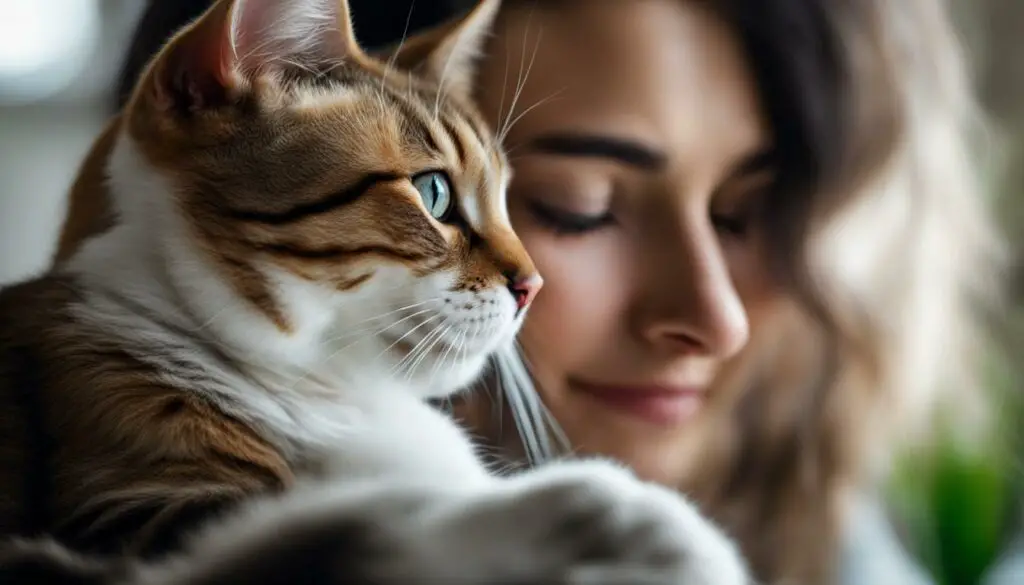
The Importance of Trust and Communication
Trust is an essential component of the cat-owner bond. Cats need to feel safe and secure in their environment, and it is the responsibility of the owner to create a nurturing and supportive atmosphere. Avoid sudden changes or disruptions that may cause distress to your cat. Instead, establish a consistent routine and provide a stable environment that your cat can rely on.
Communication is also crucial in building and maintaining the cat-owner bond. Cats communicate through various behaviors and body language cues. Pay attention to their vocalizations, body postures, and tail movements to understand their comfort level and level of familiarity. By understanding and responding to your cat’s needs and signals, you can further deepen the emotional connection between you.
In summary, the bond between cats and their owners is a unique and special relationship. Cats have the ability to remember and recognize their owners even after a period of separation. By nurturing this bond through trust, care, and positive experiences, you can create a lifelong connection with your feline companion.
Factors That Influence Cat Memory
When it comes to cat memory, several factors can have an impact on how well they remember specific individuals or experiences. One of the key factors is environmental changes. Cats are creatures of habit and thrive on routine, so any significant changes to their environment can disrupt their memory. Moving to a new home, introducing new pets, or even rearranging furniture can all affect a cat’s ability to recall familiar faces and places.
Another factor that can influence cat memory is disruptions to their routine. Cats are creatures of habit and rely on a predictable schedule. Any sudden changes or disruptions, such as changes in feeding times or inconsistent playtime, can impact their memory and ability to remember specific individuals. Maintaining a consistent routine is crucial for supporting a cat’s memory and overall well-being.
Additionally, stress can play a role in cat memory. Cats are sensitive animals, and high-stress situations can interfere with their ability to remember. Whether it’s due to a change in their environment or a traumatic event, stress can affect a cat’s memory and their ability to recall familiar faces and experiences. Providing a calm and stress-free environment is essential for supporting a cat’s memory function.
| Factors That Influence Cat Memory |
|---|
| Environmental Changes |
| Routine Disruptions |
| Stress |
In summary, factors such as environmental changes, routine disruptions, and stress can all influence a cat’s memory. Understanding and mitigating these factors can help support a cat’s memory function and enhance their ability to remember familiar faces and experiences.
The Effects of a 3-Month Separation
A 3-month separation from your cat can have a significant impact on their memory and the bond between you. It’s natural for cats to initially show signs of confusion or aloofness upon reunion, as they may need time to readjust and re-establish familiarity. However, with patience and understanding, you can help your cat remember you and strengthen your bond over time.
Signs of Recognition and Reconnection
After a 3-month separation, cats may display various signs of recognition and affection when reuniting with their owner. These signs can include purring, rubbing against you, or seeking your attention. Their behavior is an indication that they remember and have a bond with you. In some cases, cats may also exhibit cautious behavior as they gradually reacquaint themselves with their environment and your presence.
Creating a safe and secure environment is crucial during this period of reconnection. Provide a familiar space with their favorite toys, bedding, and scratching posts. Avoid overwhelming them with excessive attention or sudden changes, as this can cause stress and hinder the rebuilding of trust and familiarity.
| Signs of Recognition and Affection | Behaviors |
|---|---|
| Purring | Indicates contentment and recognition |
| Rubbing against you | Sign of familiarity and marking territory |
| Seeking your attention | Shows a desire for interaction and connection |
“The ability to re-establish a strong bond with your cat depends on the relationship you had prior to the separation and the efforts you make to reconnect with them.”
Rebuilding trust and strengthening the bond will take time and patience. Engaging in activities your cat enjoys, such as playtime and grooming, can help facilitate the reconnection process. Offering treats and positive reinforcement can also reinforce the positive association with your presence. Remember to respect their boundaries and give them space when needed.
Every cat is unique, and the time it takes to re-establish a strong bond will vary. Some cats may need more time and reassurance, while others may readily reconnect. By recognizing their individual needs and providing a loving and understanding environment, you can successfully navigate the challenges of a 3-month separation and create an even deeper bond with your feline companion.
Tips for Reconnecting with Your Cat
Reuniting with your cat after a 3-month separation can be an emotional and exciting time. To ensure a smooth transition and rebuild the bond with your furry friend, there are several tips and activities you can try:
Create a Familiar Environment
Set up your home to be a comforting and familiar space for your cat. Place their bed, toys, and scratching posts in the same locations as before the separation. This will help your cat feel secure and reduce any anxiety they may have.
Spend Quality Time Together
Engage in activities that your cat enjoys, such as playing with interactive toys or engaging in gentle grooming sessions. This will help strengthen the bond between you and provide opportunities for your cat to remember and reconnect with you.
Offer Treats and Positive Reinforcement
Cats respond well to positive reinforcement, so be sure to reward them with treats and praise when they exhibit desired behaviors. This will reinforce their connection with you and motivate them to engage in activities that strengthen your bond.
Remember, every cat is unique, so take the time to observe and understand their preferences. By being patient, consistent, and showing love and care, you can successfully rebuild the bond with your cat and create a strong and lasting relationship.
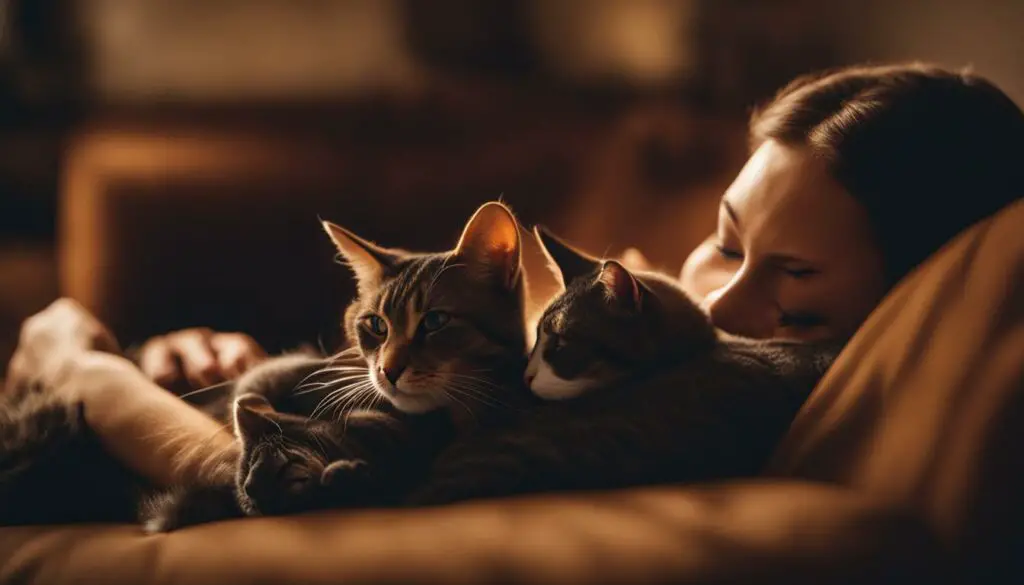
Understanding Cat Behavior
Understanding cat behavior is crucial for reconnecting with your feline companion after a separation. Cats communicate through a variety of behaviors and body language cues, which can provide valuable insights into their comfort and level of familiarity. By paying attention to their vocalizations, body postures, and tail movements, you can better understand their needs and emotions.
One important aspect of cat behavior is vocalization. Cats have different types of vocalizations, such as meowing, purring, hissing, and growling, each conveying a specific message. For example, a deep purr is often a sign of contentment and relaxation, while an intense hiss indicates aggression or fear. Understanding the meaning behind these vocalizations can help you gauge your cat’s mood and adjust your actions accordingly.
In addition to vocalizations, cats also communicate through body postures and tail movements. A relaxed and open body posture with a loosely wagging tail typically indicates that a cat is feeling comfortable and friendly. On the other hand, a tense body posture with an upright and puffed-up tail may indicate that a cat is feeling threatened or defensive. By observing these cues, you can create a safe and supportive environment for your cat.
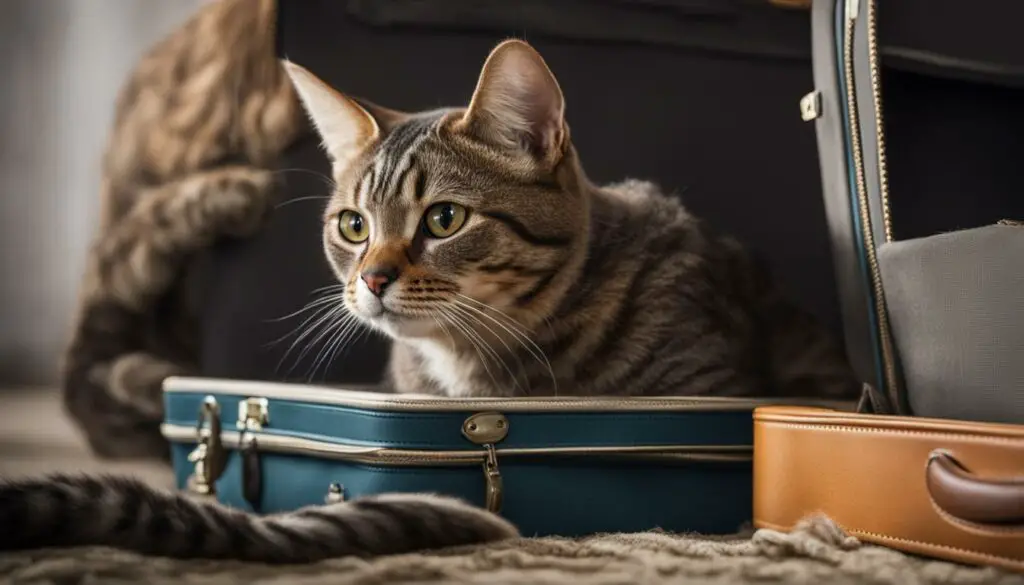
Cat behavior is complex and can vary between individuals. However, by familiarizing yourself with common behaviors and body language cues, you can enhance your ability to connect with your cat and strengthen your bond. Remember, patience, empathy, and understanding are key to developing a harmonious relationship with your feline companion.
Signs of Recognition and Affection
When you are reunited with your beloved cat after a 3-month separation, it’s natural to wonder if they will remember you. Thankfully, cats have remarkable memory capabilities and can show signs of recognition and affection upon seeing their owner again.
One of the most common signs of recognition is purring. When a cat purrs in your presence, it signifies that they are pleased to see you and remember the bond you share. Additionally, cats may show affection by kneading, a rhythmic motion with their paws often accompanied by purring. This behavior is an expression of comfort and trust towards their owner.
Cats also exhibit recognition and affection through physical contact. They may rub against you, their body language signaling familiarity and a desire for closeness. Seeking your attention by meowing or following you around the house is another way cats express their recognition and affection. These behaviors demonstrate that your cat remembers you and cherishes your companionship.
“Cats show signs of recognition and affection through purring, kneading, rubbing against their owner, and seeking attention.”
Understanding your cat’s body language is crucial in recognizing signs of recognition and affection. Dilated pupils, relaxed body posture, and an upright tail are positive indications that your cat remembers and acknowledges you. Conversely, if your cat avoids eye contact, displays tense body language, or hisses, they may require more time and patience to rebuild the bond with you.
By observing these signs of recognition and affection, you can feel reassured that your cat remembers you after a 3-month separation. It is a testament to the deep bond and emotional connection that you have developed over time.
| Signs of Recognition and Affection in Cats |
|---|
| Purring |
| Kneading |
| Rubbing against their owner |
| Seeking attention |
| Dilated pupils |
| Relaxed body posture |
| Upright tail |
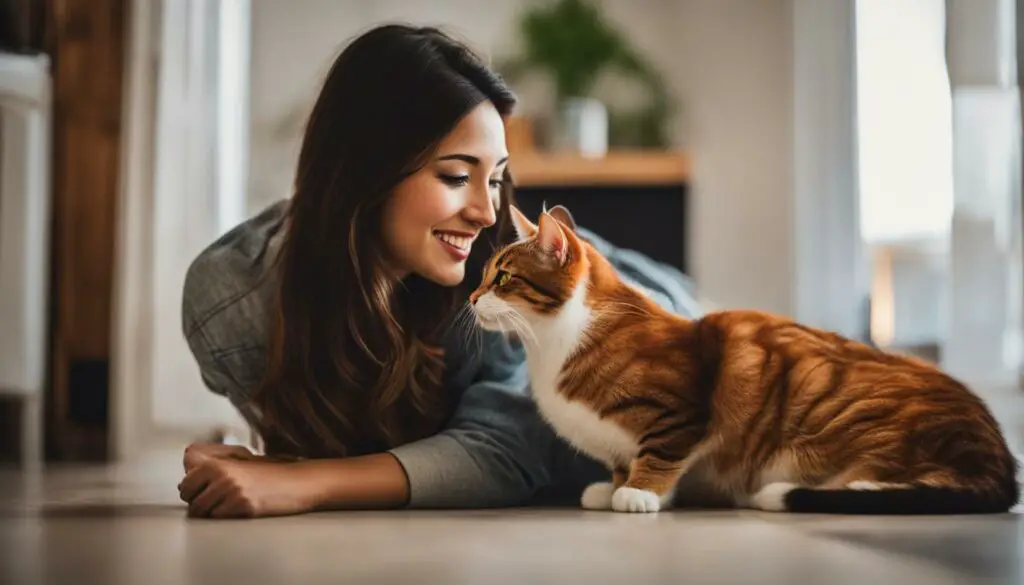
Building Trust and Security
Building trust and creating a secure environment are crucial for strengthening the bond between you and your cat. By prioritizing their safety and comfort, you can ensure a strong and loving relationship. Here are some key factors to consider:
Providing a Safe Space
Cats thrive in environments where they feel safe and secure. Create a designated area in your home that’s just for your cat, equipped with their favorite toys, scratching posts, and cozy resting spots. This space will become their sanctuary, where they can retreat to whenever they need a sense of security.
Maintaining Consistency
Consistency is key when it comes to building trust with your cat. Stick to a regular schedule for feeding, playtime, and other daily activities. Cats appreciate routine and knowing what to expect, so providing this stability will help them feel more at ease and confident in your care.
Positive Reinforcement
Positive reinforcement is an effective tool for fostering trust and security. Reward your cat with praise, treats, and gentle petting when they exhibit desired behaviors or show signs of affection. This positive association will strengthen the bond between you and encourage your cat to trust and rely on you.
| Building Trust and Security: | Key Points: |
|---|---|
| Providing a Safe Space | Create a designated area with their favorite toys and resting spots. |
| Maintaining Consistency | Stick to a regular schedule for feeding, playtime, and daily activities. |
| Positive Reinforcement | Reward desired behaviors with praise, treats, and gentle petting. |
By focusing on trust, consistency, and positive reinforcement, you can create a secure environment that strengthens the bond between you and your cat. Remember, building trust takes time and patience, so be understanding and provide plenty of love and care along the way.
Consistency and Routine
Consistency and routine are key factors in maintaining a happy and healthy cat. Cats thrive on predictability and familiarity, so establishing a consistent routine can help them feel secure and at ease. By providing a stable environment with regular feeding times, play sessions, and designated resting areas, you can create a sense of structure that your cat can rely on.
One important aspect of maintaining consistency is sticking to a regular feeding schedule. Cats are creatures of habit and rely on routine when it comes to their meals. Try to feed your cat at the same times every day, as this will not only help establish a routine but also aid in preventing obesity and other health issues. It’s also important to provide your cat with fresh water daily, ensuring they stay hydrated.
Another aspect of consistency is engaging in regular playtime sessions. Cats are natural hunters and need to exercise their instincts through play. Set aside dedicated time each day to play with your cat using toys, interactive games, or even simple activities like chasing a laser pointer. Not only will this provide mental and physical stimulation, but it will also help strengthen the bond between you and your cat.
In addition to feeding and playtime, providing a consistent environment for your cat is essential. This includes ensuring a clean litter box and maintaining a regular grooming routine. Cats are known for their cleanliness, and a dirty litter box or neglected grooming can cause stress and discomfort. Regularly clean the litter box and groom your cat based on their needs, whether it’s brushing their fur, trimming their nails, or cleaning their ears.
| Benefits of Consistency and Routine for Cats | How to Establish a Consistent Routine |
|---|---|
|
|
By prioritizing consistency and routine in your cat’s daily life, you can provide them with a stable and nurturing environment. This will not only enhance their overall well-being but also deepen the bond between you and your cat.
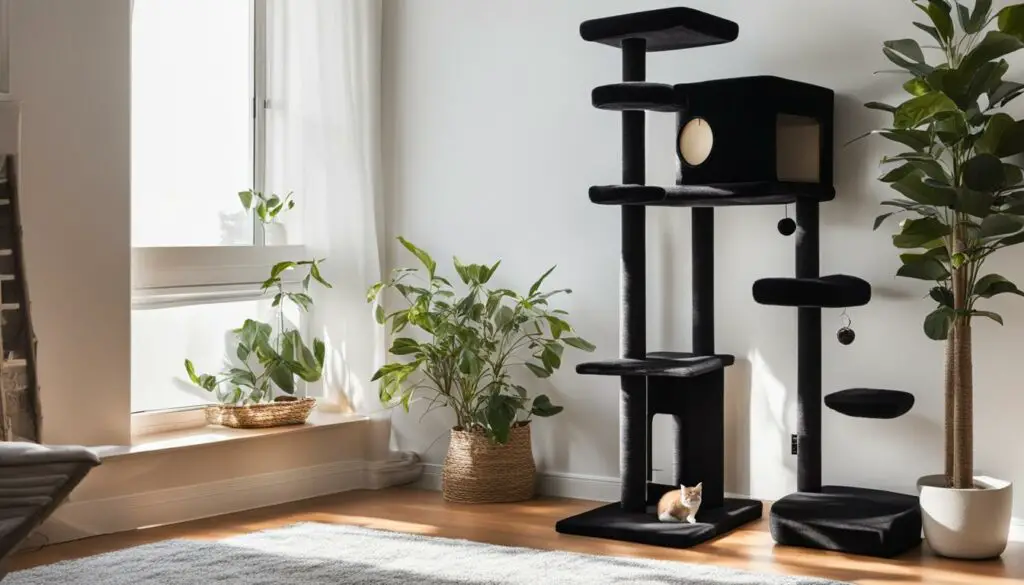
Seeking Professional Advice
If you find yourself facing challenges in reconnecting with your cat or addressing behavioral issues, consulting a feline behavior expert, also known as a cat behaviorist, can be immensely helpful. These professionals specialize in understanding feline behavior and can provide customized strategies to assist you in rebuilding the bond with your cat.
A cat behaviorist has extensive knowledge and experience in interpreting cat behavior, identifying the underlying causes of certain behaviors, and implementing effective solutions. They can offer valuable insights into why your cat may be exhibiting certain behaviors and provide guidance on how to address them.
By seeking professional help, you can gain a deeper understanding of your cat’s needs and preferences, which will enable you to create an environment that promotes trust, security, and overall well-being for your feline companion. A cat behaviorist can also provide guidance on how to establish routines, introduce new stimuli, and navigate any challenges that may arise during the reconnection process.
Consulting a feline behavior expert can be a crucial step in ensuring a successful and harmonious relationship with your cat. Their expertise and guidance will empower you to navigate any behavioral issues and strengthen the bond between you and your furry friend.

When to Seek Professional Help
If you notice persistent behavioral issues in your cat, such as aggression, excessive grooming, litter box problems, or anxiety-related behaviors, it is recommended to consult a cat behaviorist. Additionally, if you have tried various techniques to reconnect with your cat but are still facing difficulties, seeking professional advice can provide you with additional strategies and support.
Remember, every cat is unique, and their behaviors can be influenced by a variety of factors, including their individual personality, past experiences, and environment. A cat behaviorist can help you understand these complexities and guide you in creating a positive and fulfilling relationship with your beloved feline companion.
Reconnecting with Your Cat After 3 Months: Rediscovering the Bond
After a 3-month separation from your beloved feline friend, you may be wondering how to reconnect and strengthen your bond. Cats have their own unique memory capabilities and emotional connections with their owners. By understanding these factors, you can take steps to rebuild the relationship and create lasting memories together.
The connection between cats and their owners is built on trust, care, and positive experiences. Cats can recognize their owners through various sensory cues, such as scent and voice. When you reunite with your cat after a long absence, they may initially show signs of confusion or aloofness. However, with patience and effort, you can reestablish familiarity and affection.
Creating a secure and comfortable environment is crucial for rebuilding trust. Provide a space with familiar scents and objects, and maintain consistency in their routine. Spend quality time engaging in activities they enjoy, such as playtime and grooming. These interactions will help to strengthen the bond and create a sense of security for your cat.
| Reconnecting with Your Cat After 3 Months: Tips |
|---|
| Establish a familiar environment with their favorite toys and resting areas |
| Spend quality time engaging in activities they enjoy, such as playtime and grooming |
| Offer treats and positive reinforcement to strengthen the bond |
| Pay attention to their body language and vocalizations to gauge their comfort |
| Be patient and allow time for your cat to adjust and reconnect with you |
By following these tips and understanding your cat’s behavior, you can successfully reconnect with your furry friend. Remember, building a strong and loving relationship requires time, effort, and patience. Cherish the moments you spend together and create new memories as you continue to deepen your bond.
Additional Considerations
While cats generally have the capacity to remember their owners after a 3-month separation, it’s important to understand that each cat is unique, and their memory and bonding capabilities can vary. Some cats may require more time and effort to rebuild trust and connection compared to others. It’s essential to be patient and provide the necessary support to help your cat feel secure and comfortable during the reconnection process.
If you find yourself unable to care for a cat due to lifestyle changes or other circumstances, it’s crucial to consider responsible alternatives such as cat adoption or fostering. By opting for these options, you can ensure the well-being and happiness of the cat while also promoting responsible pet ownership. Many animal shelters and rescue organizations offer guidance and assistance in finding the right fit for both you and the cat in need of a loving home.
Remember that owning a cat is a lifelong commitment, and responsible pet ownership includes providing proper care, regular veterinary check-ups, nutrition, exercise, and a safe environment. Cats bring joy and companionship to our lives, and it’s our responsibility to reciprocate that love and care throughout their lives.
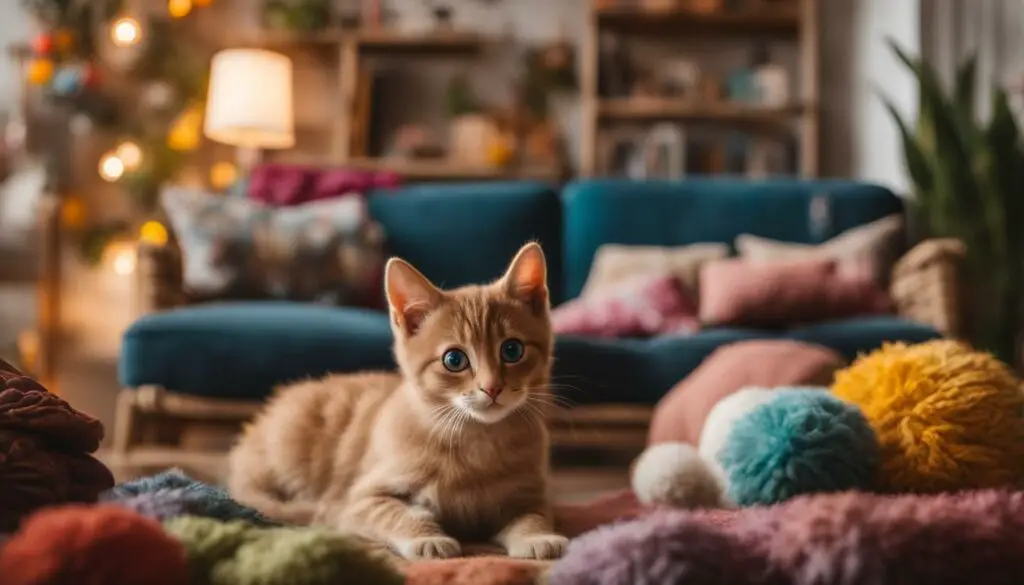
By being mindful of these additional considerations, and by taking into account the unique needs and characteristics of your cat, you can ensure a harmonious and loving relationship that lasts a lifetime.
Section 14: Resources for Cat Owners
As a cat owner, it’s essential to have access to resources and support networks to provide the best care for your feline companion. Fortunately, there are numerous cat care resources, behavior resources, and cat owner support options available to help guide you in your journey of cat ownership.
One valuable resource is online platforms and forums dedicated to cat owners. These platforms provide a space for cat enthusiasts and experts to share advice, tips, and support. Joining these communities can give you a wealth of knowledge and the opportunity to connect with other cat owners who have experienced similar challenges and successes.
Apart from online resources, consulting a professional cat behaviorist can be immensely beneficial. These experts specialize in understanding feline behavior and can provide customized strategies to help you address any behavioral issues and rebuild the bond with your cat after a separation.
Remember, responsible pet ownership involves continuous learning and growth. By leveraging the resources available to you, you can enhance your understanding of cats and provide the best possible care for your furry companion.
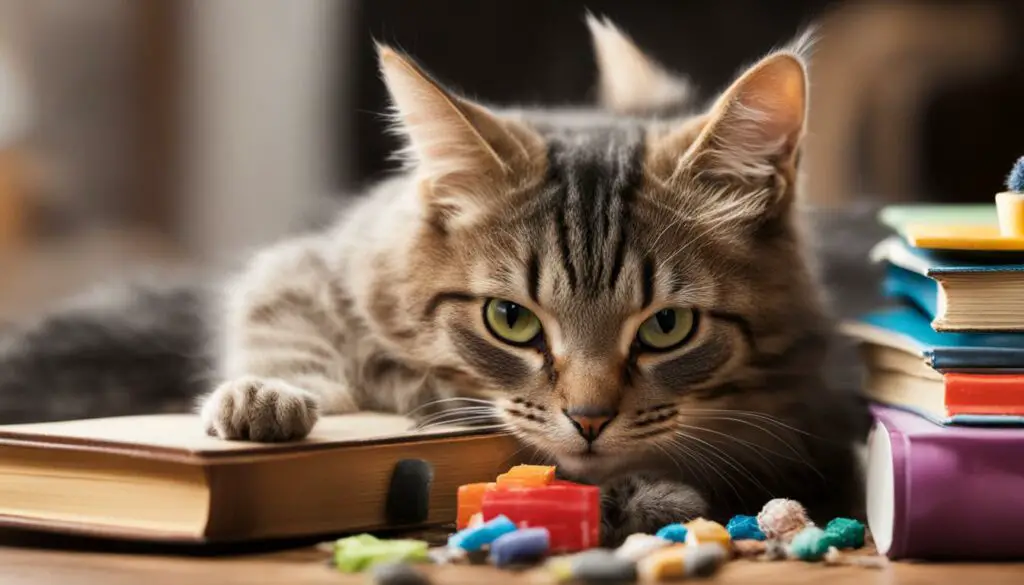
Maintaining a Strong and Loving Relationship
Building a strong and loving relationship with your cat is a rewarding and fulfilling experience. It requires time, effort, and understanding to nurture a bond of trust and companionship. Here are some cat care tips to help you maintain a strong connection with your feline friend:
Create a Comfortable Environment
Cats thrive in a secure and comfortable environment. Provide them with a designated space that includes their favorite toys, scratching posts, and resting areas. Avoid sudden changes or disruptions that can undermine their sense of security. By giving your cat a safe and welcoming space, you are creating an environment where they can feel relaxed and happy.
Establish Consistency and Routine
Cats are creatures of habit and thrive on consistency and routine. Establish a regular feeding schedule, playtime routine, and designated resting areas. This will help your cat feel secure and comfortable, as they will know what to expect from their daily routine. Consistency in your interactions and care will contribute to the bond between you and your cat.
Nurture with Love and Affection
Show your cat love and affection through gentle petting, brushing, and cuddling. Spend quality time with your cat, engaging in activities they enjoy, such as interactive play and grooming sessions. Create a strong bond through positive reinforcement, treats, and verbal praise. This will strengthen your cat-owner relationship and create a loving connection.
| Cat Care Tips | Benefits for the Relationship |
|---|---|
| Regular playtime | Stimulates bonding and relieves stress |
| Gentle grooming | Strengthens the bond through physical touch |
| Providing a safe environment | Builds trust and a sense of security |
| Consistent care and routines | Maintains a stable and predictable environment |
By following these Cat Care Tips, you can maintain a strong and loving relationship with your furry companion. Remember, each cat is unique, and it may take time and patience to strengthen your bond. Cherish the moments of love and companionship you share, and continue to provide the care and attention your cat deserves.
Image source: https://seo writing.ai/32_6.png
Reconnecting with Your Cat After 3 Months: A Journey of Love and Memories
After being separated from your beloved feline companion for three long months, you may be wondering how to reconnect and rebuild the bond you once shared. The journey of reconnecting with your cat is a testament to the love and memories you have together, and it is a journey that requires patience, understanding, and a little bit of effort.
Cats have their own unique way of remembering and recognizing their owners. While their memory may not be as strong or long-lasting as ours, the bond between you and your cat can help facilitate the reconnection. By providing a familiar environment, spending quality time together, and offering positive reinforcement, you can gradually rebuild the trust and affection that once existed.
Understanding cat behavior is key to strengthening your bond. Pay attention to their vocalizations, body language, and tail movements to gauge their comfort level and familiarity. When your cat shows signs of recognition and affection, such as purring, kneading, or seeking your attention, it is a heartwarming indication that they remember and have a strong connection with you.
Maintaining consistency and routine is essential for a successful reunion. Cats thrive on stability, so establish a regular feeding schedule, playtime routine, and designated resting areas. Consistency in your interactions and care will go a long way in reestablishing the bond and deepening the relationship with your furry friend.
Reconnecting with your cat after a 3-month separation is a journey filled with love, memories, and the joy of the unique bond you share. By understanding their memory capabilities, following the provided tips, and seeking professional guidance when needed, you can create a lasting and fulfilling relationship with your beloved feline companion.
FAQ
Will my cat remember me after 3 months?
Cats have the capacity to remember their owners even after a 3-month separation. While their memory may not be as strong or long-lasting as humans’, the bond between cats and their owners can help facilitate recognition and reconnection.
How does cat memory work?
Cats have both short-term and long-term memory capabilities. They can retain memories of familiar faces and places, though the exact duration of their memory retention is not fully understood.
What factors can influence a cat’s memory?
Environmental changes and disruptions to their routine can affect a cat’s memory and their ability to remember specific individuals or experiences.
How will a 3-month separation affect my cat’s memory?
A 3-month separation may initially cause confusion or aloofness in cats, but over time, they are likely to recognize their owner and show signs of familiarity.
How can I reconnect with my cat after a 3-month separation?
To reconnect with your cat, start by providing a familiar environment with familiar scents and objects. Spend quality time engaging in activities they enjoy, offer treats, and provide positive reinforcement.
What should I pay attention to in my cat’s behavior?
Pay attention to your cat’s vocalizations, body postures, and tail movements to gauge their comfort and level of familiarity.
How do I know if my cat remembers me?
If your cat displays signs of affection like purring, kneading, rubbing against you, or seeking your attention upon reunion, it is a positive indication that they remember and have a bond with you.
How can I build trust and create a secure environment for my cat?
Provide a safe and comfortable space with access to their favorite toys, scratching posts, and resting areas. Avoid sudden changes or disruptions to maintain their sense of security.
How important is consistency and routine for my cat?
Cats thrive on consistency and routine. Establish a regular feeding schedule, playtime routine, and designated resting areas to help your cat feel secure and comfortable.
What if I encounter challenges in reconnecting with my cat?
Seeking professional advice from a qualified feline behaviorist can provide guidance and customized strategies to assist you in reconnecting with your cat.
Are there resources available for cat owners?
Yes, various online platforms, forums, and community groups cater to cat owners, offering advice, tips, and support from fellow cat enthusiasts and experts.
How can I maintain a strong and loving relationship with my cat?
Regular interactions, consistent care, and a nurturing environment contribute to a fulfilling and lifelong bond with your cat. Cherish the unique connection you share and provide love and care throughout their lives.
What should I consider if I am unable to care for my cat?
If you are unable to care for a cat, consider options such as adoption or fostering to ensure their well-being and happiness.
Source Links
- https://vethelpdirect.com/vetblog/2020/07/09/why-does-my-cat-bite-me-unprovoked/
- https://www.arcticinsider.com/arctic-cat-catalyst-deeper-dive-videos-engineering-interviews/
- https://www.theautopian.com/the-four-kittens-living-in-my-holy-grail-jeep-grand-cherokee-are-wreaking-havoc-and-im-totally-cool-with-it/








